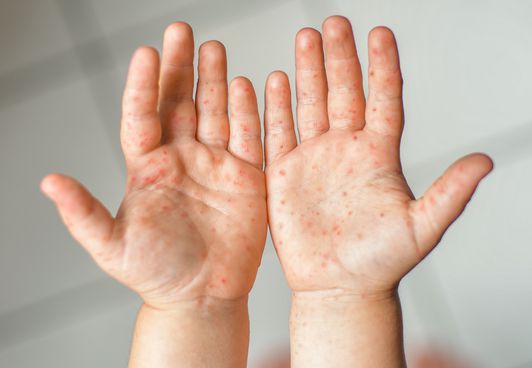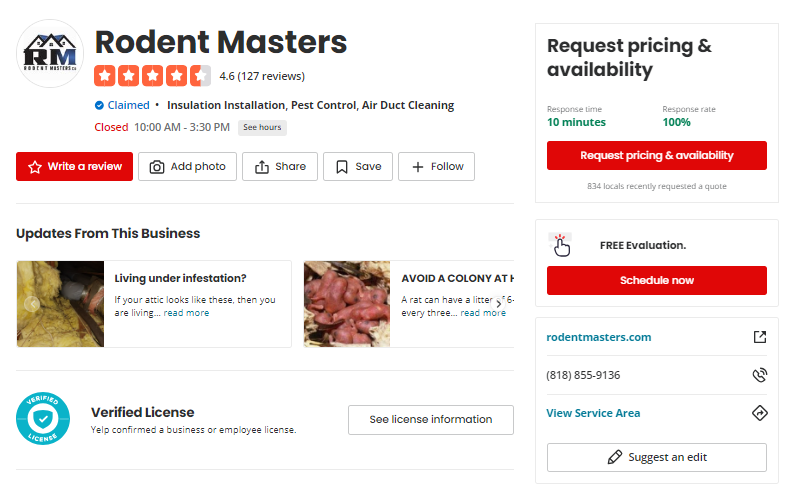Rodents like rats, mice, and chipmunks carry many diseases. Diseases can spread to people directly and indirectly from rodents. The following list provides links to more information about some diseases that can spread from rodents; these are not exhaustive lists.

Certain diseases can spread from rodents to people through direct contact with infected rodents (for example, breathing in contaminated air, touching contaminated materials and then touching eyes, noses, or mouths, being bitten or scratched by an infected rodent, or eating food contaminated by an infected rodent).
Also diseases can spread from rodents to people through indirect contact. This can occur when people are bitten by ticks, mites, fleas, and mosquitoes that have fed on infected rodents. Diseases can also spread to people from rodents through the consumption of an intermediate host (for example, beetles or cockroaches).


Read below to learn about diseases that can be spread by small mammals, and visit the Healthy People section to learn about staying healthy around small mammals.
Campylobacteriosis (Campylobacter spp.)
Campylobacteria are bacteria that can sicken people and animals with campylobacteriosis disease. This bacteria can infect rodents like hamsters, guinea pigs, and gerbils.
How it spreads: Campylobacter most often spreads between animals and people through feces (poop), contaminated food or water, or the environment. People can become infected if they don’t wash their hands after touching an infected animal or its poop, food, toys, or habitat.
Who is at risk: Anyone can get a Campylobacter infection, but children younger than five years old, adults 65 years and older, and people with weakened immune systems are more likely to get severe illness.
Signs in small mammals: Some infected animals might have diarrhea, but others might not show any signs of illness.
Symptoms in people: People can have diarrhea (often bloody), fever, and stomach cramps. The diarrhea may be accompanied by nausea and vomiting. Symptoms usually start within 2–5 days after infection and last about one week.
Giardia is a parasite found on surfaces or in water, food, or soil that the poop of an infected person or animal has contaminated. This parasite is uncommon among small mammals but can infect chinchillas, rats, and mice.
How it spreads: You can get giardiasis if you swallow giardia germs. Giardia spreads quickly and can spread from person to person or through water, food, surfaces, or objects contaminated with poop from infected people or animals.
Who is at risk?
The risk of getting Giardia from small mammals is low. The type of Giardia that makes people sick usually differs from that that infects animals. Anyone can get Giardia, but the following groups have a higher risk:
People who are in close contact with someone who has the disease.
Travelers within areas that have poor sanitation.
People who have contact with poop during sexual activity.
People who drink untreated water from springs, lakes, or rivers
Swimmers who swallow water from swimming pools, hot tubs, splash pads, or untreated recreational water from springs, lakes, or rivers
People who get their household water from a shallow well
People with weakened immune systems.
People who have contact with infected animals or animal environments contaminated with poop
Signs in small mammals: Infected animals often have diarrhea, gas, greasy poop, and dehydration. Some pets don’t show any signs of illness.
Symptoms in people: Infected people often have diarrhea, greasy poop, dehydration, abdominal cramps, nausea, and vomiting. Symptoms usually begin 1 to 2 weeks after infection and last 2 to 6 weeks. Some people don’t have any symptoms.
Leptospirosis (Leptospira spp.)
Leptospirosis is a bacterial disease that can affect people and animals. Many animals, including rodents like mice and rats, can carry the bacteria in their urine.
How it spreads: The bacteria that cause leptospirosis spread through the urine of infected animals, which can get into water or soil and survive there for weeks to months. Some animals that can spread leptospirosis include cattle, pigs, horses, dogs, rodents, and wild animals. People get infected through contact with urine or other body fluids (except saliva) from infected animals or with water, soil, or other materials (such as animal bedding) contaminated with urine from infected animals.
Who is at risk? Leptospirosis occurs worldwide but is most common in tropical and subtropical climates. It has been associated with contact with infected animals and activities in contaminated lakes and rivers, such as swimming, wading, kayaking, and rafting. It is also a risk for people in jobs involving contact with animals or their waste, like farmers, sewer workers, slaughterhouse workers, and veterinarians.
Signs in small mammals: Rodents infected with leptospirosis may not show any signs of illness.
Symptoms in people: People with leptospirosis might not have any symptoms, but those who do will usually become sick within two days to four weeks of exposure and can have a high fever, headache, chills, muscle aches, vomiting, jaundice, conjunctivitis (red eyes), abdominal pain, diarrhea, or a rash. A small number of people with leptospirosis can have more severe diseases, such as liver and kidney failure, hemorrhagic pneumonia, and even death. Early treatment with appropriate antibiotics is essential and can reduce the duration and severity of the illness.
Lymphocytic Choriomeningitis Virus (LCMV)
Lymphocytic choriomeningitis is a rare viral disease spread by rodents, mainly the ordinary house mouse. It can infect hamsters, guinea pigs, rats, and other small rodents.
How it spreads: LCMV spreads through contact with the urine, poop, saliva, or bedding of infected rodents, especially in broken skin or the nose, eyes, or mouth. Rodent bites can also spread the virus. Pregnant people can spread the virus to their fetus.
Who is at risk? Anyone in contact with infected rodents can become infected with LCMV, but most people won’t get seriously sick. Young children, pregnant people, and people with weakened immune systems are most at risk for severe disease. LCMV is especially dangerous for pregnant people, who can pass the infection to their fetus, which can cause severe congenital disabilities.
Signs in small mammals: Infected rodents often look healthy or have small decreases in activity and appetite. Later, these infected animals may show weight loss, poor hair coat, or hunched posture, and some may die.
Symptoms in people: LCMV infections are rare in people. Infected people might have a fever, stiff neck, loss of appetite, muscle aches, headaches, nausea, and vomiting. LCMV infection can also affect the brain and spinal cord during the second phase of the illness. Symptoms usually appear 1 to 2 weeks after exposure. LCMV infection during the first trimester of pregnancy may result in fetal death or miscarriage, while in the second and third trimesters, congenital disabilities can develop in the fetus.
Sarcoptic Mange (Trixacarus caviae)
Sarcoptic mange is a parasitic skin disease caused by tiny mites. Guinea pigs commonly get these mites, but they are not the same type of mites that cause scabies in people.
Mites and How They Spread: Guinea pigs can be managed through close contact with animals infested with mites, contaminated bedding, or other materials. Trixacarus caviar mites cannot invade or spread from person to person, but they can affect a person who has close contact with an infested guinea pig. The mite will not be able to reproduce on the person, though, and will die on its own in a couple of days.
Who is at risk? Trixacarus caviar mites can affect anyone who handles an infected animal.
Signs in guinea pigs: Infected animals often have hair loss, itching, and skin irritation.
Symptoms in people: People cannot become infested with the animal versions of sarcoptic mange. However, contact with an infected animal could cause temporary skin irritation.
Rat-bite fever (RBF) is a rare disease spread by rats that is caused by Streptobacillus moniliformis and Spirillum minus bacteria. It is also known as Haverhill fever. Other rodents, like mice, guinea pigs, and gerbils, can also carry and spread the bacteria.
How it spreads: The bacteria that cause RBF spread through bites or scratches from infected rodents. People also can get sick through contact with rodent urine or poop or through contaminated food or water. Rat-bite fever does not spread from person to person.
Who is at risk? People at higher risk for rat-bite fever include those with pet rats or other rodents in their home, those using feeder rodents, and those who work with rats or other rodents. Children 5 years old or younger, pregnant people, and people with weakened immune systems are most at risk for severe disease.
Signs in rodents: Infected rodents might have arthritis, skin infections, pneumonia, or swollen lymph nodes. Some infected rats might look healthy.
Symptoms in people: Infected people can have fever, vomiting, headache, muscle pain, joint pain or swelling, and a rash. If left untreated, RBF can spread to the joints, liver, heart, lungs, brain, and blood.
Ringworm is a fungal disease that can affect people’s and animals’ skin, hair, or nails.
How it spreads: Ringworm spreads through contact with an infected person’s or animal’s skin or from the environment.
Who is at risk? Anyone can get ringworm.
Signs in small mammals: Infected animals, usually guinea pigs, might have circular areas of hair loss and crusts anywhere on their body. Infected rodents and rabbits might have areas with mild hair loss and reddened, irritated, itchy, or flaky skin.
Symptoms in people: Ringworm infections are usually itchy and can appear on almost any body part. Redness, scaling, cracking of the skin, or a ring-shaped rash may occur. Hair may fall out if the infection is on the scalp or beard. Infected nails can become discolored, thick, or crumble.
Salmonellosis (Salmonella spp.)
Salmonella are bacteria that can make people and animals sick with salmonellosis.
How it spreads: People can get infected with Salmonella by eating contaminated food or through contact with an animal or its poop, food, habitat, or items like toys and food dishes. People can get sick if they don’t wash their hands after touching their small mammal or anything in its environment and then touching their mouth and swallowing Salmonella germs.
Who is at risk: Anyone can get sick from Salmonella, but children younger than five years old, adults 65 and older, and people with weakened immune systems are more likely to get severe illness.
Signs in small mammals: Salmonella bacteria live in the gastrointestinal tracts of healthy rodents and small mammals. Salmonella infection usually doesn’t make these animals sick.
Symptoms in people: Most people infected with Salmonella have diarrhea, fever, and stomach cramps. Symptoms usually start 6 hours to 6 days after swallowing the bacteria. Most people recover without treatment after 4 to 7 days.
The Seoul virus is a type of hantavirus. Like other species of hantavirus, the Seoul virus is spread by rodents (specifically the Norway rat and the black rat).
How it spreads: People can get infected with the Seoul virus by breathing in tiny particles of rodent urine, poop, or saliva. The Seoul virus can also spread through bites from infected rats or by consuming food contaminated by infected rats.
Who is at risk? Anyone can get the Seoul virus, but people who handle or are around rodents are more at risk. Children 5 years old or younger, pregnant people, and people with weakened immune systems are more likely to get severe illness from the Seoul virus.
Signs in rodents: Rats infected with the Seoul virus don’t show any symptoms of the disease.
Symptoms in people: Infected people might have fever, headache, muscle aches, vomiting, diarrhea, abdominal pain, dizziness, and chills. However, some people do not get symptoms at all. Symptoms usually appear 1 to 2 weeks after exposure. Rarely, it may take up to 8 weeks to develop symptoms.

